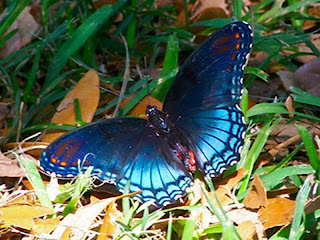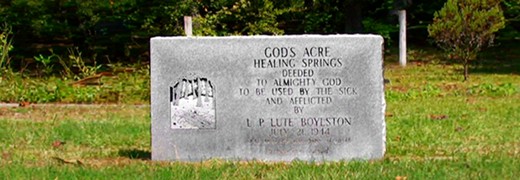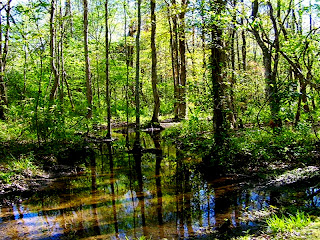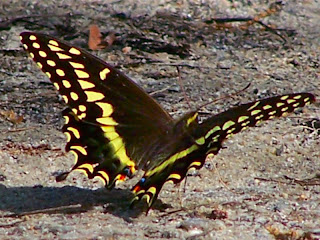In 1748, a seven year old girl named Catherine Chicken was tied to a headstone in the chapel graveyard by the town schoolmaster, and left there overnight.
 |
| Strawberry Chapel. |
Strawberry Chapel
Link goes to sciway.net website. (page will open in new tab/window)
was built in 1775 as a parochial Chapel of Ease with the authority to bury the dead and perform baptisms.At the time, the local parish church was Biggin Church,
Biggin Church Ruins
All that remains are the crumbling walls of the church.The graveyard however, is still in use today. the ruins of which lie about 10 miles to the North, past Mepkin Abbey
Mepkin Abbey
A Trappist monastery located in Berkeley County, SC. A group of Roman Catholic monks who follow the Rule of St. Benedict. A Branch from the Order of Cistercians of Strict Observance. .There are many stories surrounding the chapel, most of them wildly exaggerated or entirely fabricated. Superstitious folks consider it to be one of the Charleston area's haunted attractions. At least one of the stories appears to be true, and that is the story of Catherine Chicken.
Naturally, countless variations of Miss Chicken's story exist, some more embellished than others. But the most common and more verifiable elements follow.
It is a rather long story, but read on... It's worth it.
Catherine Chicken was the granddaughter of James Child, who founded the town of Childsbury in 1707. Her father, George Chicken, was a member of the Goose Creek militia who was involved in driving the Yemassee Indians out of the state.
Catherine was sent to boarding school in Childsbury, and placed in the care of the harsh and extremely strict schoolmaster and his wife, Monsieur and Madame Dutarque.
One day Catherine lost track of time while playing outside, and as a result, she returned late without having completed the chores or punishments she had been given earlier.
The schoolmaster went into a rage, telling her that if she insisted on being outdoors, then outdoors is where she would stay for the night. He tied her to a headstone in the Chapel graveyard, and left her there.
A neighbor heard her cries and initially mistook the sound for an owl, but he soon began to think it sounded like Catherine. He went to the Dutarque's home to check on her, but was told that Catherine was staying with her aunt.
Sensing that something wasn't right, he saddled up his horse and rode to the aunt's home only to learn that Catherine was not there. He alerted the townsfolk that the girl was missing, and a search ensued.
A young slave boy by the name of Mooney was prowling about in the area. Mooney was prone to sneaking out at night for jaunts through the forest and swamp. He he carried with him a long tree branch, and he had fastened a gourd to the end of it. The gourd had been carved with the image of a face, and he would place a lighted candle inside. He carried the branch with the lighted gourd held high, giving the illusion of a ghostly demonic glowing face floating through the woods at night.
Mooney may very well have been frightened by the sounds of moaning coming from the graveyard, but seven-year-old little Catherine, tied to a tombstone in a graveyard at night, was likely much more frightened by that glowing floating face approaching her.
He found her quite by accident, but was afraid to call attention to her thinking he might be beaten for being out after curfew. He was unable to untie her, but stayed with her until he heard the delirious girl cry out the schoolmaster's name and ask why he had left her there. Mooney worried that the word of a slave would never be taken over that of the respected schoolmaster but ran to the local town doctor anyway, to report what he had found.
Catherine was not expected to live. She was struck mute, and her face was drooped with palsy. She was bedridden for days, and though she thrashed about in the throes of obvious nightmares, she didn't speak or utter a sound.
She survived, and eventually she mostly recovered but was disfigured for the remainder of her life.
The schoolmaster was stripped to his undergarments, tied in a rear-facing position to the back of a donkey, and ceremoniously drummed through the center of town by the militia's drummer-boys as the residents pelted him with rocks, fruit, and eggs as he passed through town. Still tied to the mule, he was placed aboard a ferry to cross the river, where the mule was struck with a whip. The mule bolted into the woods, still carrying the backward-facing, nearly-naked Monsieur Dutarque on its back.
The town of Childsbury was wiped out by a malaria epidemic in the 1750s, and no longer exists. Only the vandalized ruins of the chapel and accompanying graveyard remain.
A neighbor heard her cries and initially mistook the sound for an owl, but he soon began to think it sounded like Catherine. He went to the Dutarque's home to check on her, but was told that Catherine was staying with her aunt.
Sensing that something wasn't right, he saddled up his horse and rode to the aunt's home only to learn that Catherine was not there. He alerted the townsfolk that the girl was missing, and a search ensued.
A young slave boy by the name of Mooney was prowling about in the area. Mooney was prone to sneaking out at night for jaunts through the forest and swamp. He he carried with him a long tree branch, and he had fastened a gourd to the end of it. The gourd had been carved with the image of a face, and he would place a lighted candle inside. He carried the branch with the lighted gourd held high, giving the illusion of a ghostly demonic glowing face floating through the woods at night.
Mooney may very well have been frightened by the sounds of moaning coming from the graveyard, but seven-year-old little Catherine, tied to a tombstone in a graveyard at night, was likely much more frightened by that glowing floating face approaching her.
He found her quite by accident, but was afraid to call attention to her thinking he might be beaten for being out after curfew. He was unable to untie her, but stayed with her until he heard the delirious girl cry out the schoolmaster's name and ask why he had left her there. Mooney worried that the word of a slave would never be taken over that of the respected schoolmaster but ran to the local town doctor anyway, to report what he had found.
Catherine was not expected to live. She was struck mute, and her face was drooped with palsy. She was bedridden for days, and though she thrashed about in the throes of obvious nightmares, she didn't speak or utter a sound.
She survived, and eventually she mostly recovered but was disfigured for the remainder of her life.
The schoolmaster was stripped to his undergarments, tied in a rear-facing position to the back of a donkey, and ceremoniously drummed through the center of town by the militia's drummer-boys as the residents pelted him with rocks, fruit, and eggs as he passed through town. Still tied to the mule, he was placed aboard a ferry to cross the river, where the mule was struck with a whip. The mule bolted into the woods, still carrying the backward-facing, nearly-naked Monsieur Dutarque on its back.
The town of Childsbury was wiped out by a malaria epidemic in the 1750s, and no longer exists. Only the vandalized ruins of the chapel and accompanying graveyard remain.
Strawberry Chapel is listed in the National Register
Strawberry Chapel
Link goes to the Historical Marker Database website (hmdb.org) (page will open in new tab/window)
of Historic Places. 













